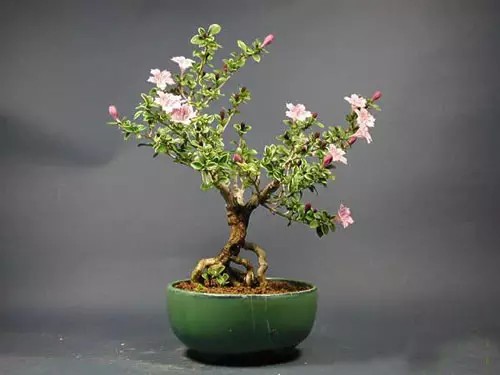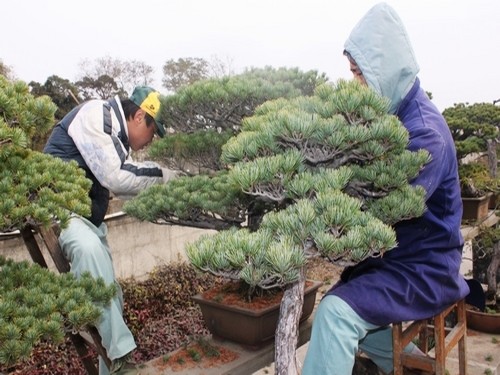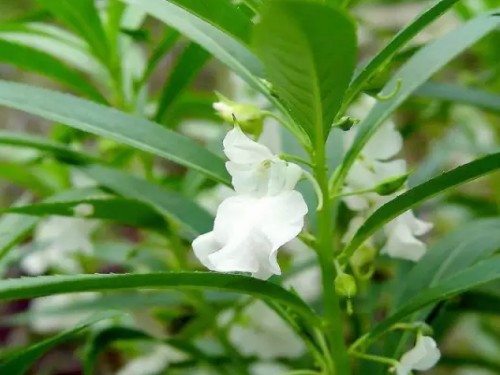Modeling method of snow bonsai in June
Different tree species have their own ways to play! As far as June snow is concerned, its Tigen is the most interesting, so I suggest: truncate the upper branches, divide the primary and secondary, lift the roots up, take your time, you can't hurry to play with bonsai!
1, processing: June snow generally uses the method of cutting and binding for modeling processing, the main branches can be properly clambered, and the rest are pruned. It is best to use brown silk in climbing, and be careful not to damage branches and bark when bending. The shape of the old root pile can also be used to lift the root to add beauty to the tree posture.
2. Tree shape: the common types of snow bonsai in June are oblique dry type, curved dry type, cliff type, jungle type, root type and so on. June snow is also suitable for landscape bonsai and flood and drought bonsai. The horizontal spread of its branches and leaves should be processed into the shape of steamed bread, but not too regular, pay attention to the changes of density. The lateral branches can droop properly and are more picturesque. June snow can also be made into stone-attached bonsai, rooted in stone gaps, hanging roots and claws, plate branches wrong section, ancient strange, quite natural wild interest.

I have cultivated June snow for 10 years, found some characteristics, and groped for some experience, which is now introduced to you for reference.
The main results are as follows: 1. Root cultivation can be induced, trapped, ligated, separated and changed.
Snow in June is easy to root, and as long as its young trees fall to the ground in one place, they will soon grow new roots. Therefore, the reproduction of snow in June can put a small basin full of culture soil around the mother tree, and then press the strong young branches on the mother tree to come into contact with the basin mud and induce new roots. After a growing season, the mother plant can be cut off and cultivated independently. This kind of seedling tree is strong and has a good foundation of modeling.
If you cultivate high-root trees with roots instead of drying, you can plant the young trees in beverage bottles with the bottom and top removed, and stand the plastic bottles in the basin mud, and then break the plastic bottles after the roots go down to the basin mud. Rinse the soil with water, adjust the root type, tie it tightly with a rope, and continue to fill the soil with plastic bottles until it is formed.
If it is a stone-attached bonsai, a long thin plate can be used to separate the potted soil into three or four high grooves from top to bottom, so that the growing roots go down without stringing each other, so as to facilitate the use of stone attached later.
For the molded June snow bonsai, if the root is unreasonable, the new method can be used to shorten or improve the new root, that is, the new root can be shortened or improved by ring peeling, and then the overlong part of the lower part can be removed.
2. The shape of stem and main support should be tied early, and the shape of branches should be cut late.
The branches of the snow in June become harder and brittle as they age. Therefore, the adjustment of the dry type should begin to bend at the seedling stage, so as to avoid cracking or breaking. For the cultivation of branches, the branches should be "cut dry and stored branches" and pruned by grades after the branches grow to a thick degree.
3. The cultivation or cushioning or pressing of branches.
Because the snow branch falls to the ground in June, it is easy to take root, which can accelerate the growth of the front branch of the root, and the branch at the back of the root grows more slowly. Use this principle to adjust the cultivation of branches, or press branches, or stand branches. If you want to cultivate jumping or conjoined jungle bonsai, press the branches and root according to the desired curve, distance and height.
4. Removal and use of tiller buds.
Tillering buds continue to grow at the base of June snow, which not only consumes nutrients, affects the growth of cultivation piles, but also causes growth confusion, affecting observation and shape, which must be removed frequently. However, some sturdy tiller buds can also be selected for cultivation to make single-stem trees double-dry and multi-dry, or to broaden, thicken and deepen the jungle.
5. "Oil Star" (lobule) should be naked in summer and winter, "Mercury" (big leaf) can grow clear in four seasons, and "color star" (Phnom Penh) should be colored with nitrogen.
Time: 2019-06-11 Click:
- Prev

How to trim five-needle pine bonsai
The modeling technology of five-needle pine bonsai not only has something in common with other tree bonsai modeling skills, but also has its own particularity. To have the characteristics of natural and appropriate choice, pruning and pruning should have a balanced layout, elegant and simple style. In order to have a broad artistic path, the author must first carry out artistic conception, type a good manuscript, and determine the theme.
- Next

How impatiens spread its seeds
Impatiens is a slow-growing plant, and you need to start the last cold-damaged seedlings in spring about three months ago. The germination of impatiens seeds may take up to 21 days and occur within the first two weeks of germination. How do impatiens spread their seeds? The wind fairy flower spreads seeds without the wind or the animals.
Related
- Fuxing push coffee new agricultural production and marketing class: lack of small-scale processing plants
- Jujube rice field leisure farm deep ploughing Yilan for five years to create a space for organic food and play
- Nongyu Farm-A trial of organic papaya for brave women with advanced technology
- Four points for attention in the prevention and control of diseases and insect pests of edible fungi
- How to add nutrient solution to Edible Fungi
- Is there any good way to control edible fungus mites?
- Open Inoculation Technology of Edible Fungi
- Is there any clever way to use fertilizer for edible fungus in winter?
- What agents are used to kill the pathogens of edible fungi in the mushroom shed?
- Rapid drying of Edible Fungi

